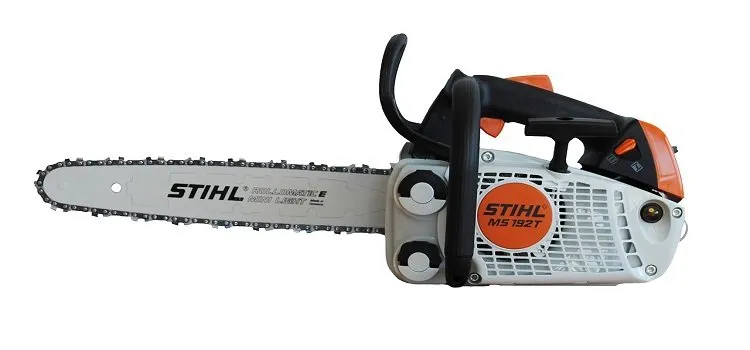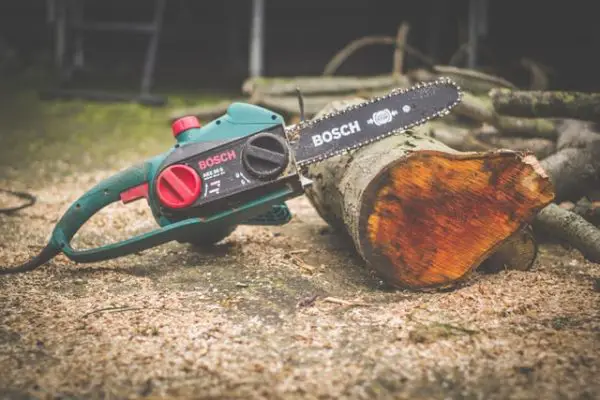The direction of a chainsaw blade will impact the longevity of the tool. Also, most importantly, you must avoid any error that may potentially lead to accidents.
Apart from placing the chainsaw blade pointed in the wrong direction, other factors that may increase the risk of accidents include mixing parts, lack of maintenance, lose parts, worn out chains, and dull chains. This article explores the direction of a chainsaw blade, including maintenance and expert tips to keep you safe and increase the longevity of your chainsaw. Also included is a guide on how to find a chainsaw chain that fits your device.
Overview
Before we begin explaining the direction of a chainsaw blade, it is essential to note the following:
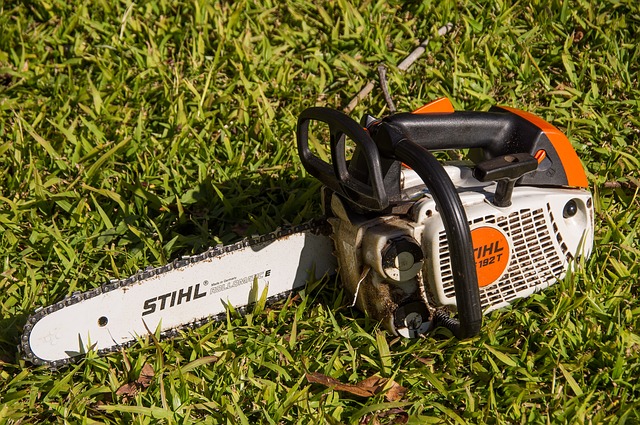
- Installing a chainsaw blade backward will impact performance and increase the possibility of kickback accidents.
- Dull chains, loose tension, improperly installed chains are the main causes of kickback accidents.
- Chainsaw blades rotate in a clockwise direction. Consequently, so should the teeth or blades.
- Regular maintenance and sharpening will keep your chainsaw in good working condition.
- Smoking, burning, or poor cutting performance are signs that you may need to replace your chainsaw blades or that the chains are installed backward.
- It is good practice to read the manual whenever you buy a new chainsaw.
What is the Proper Direction of a Chainsaw Blade?
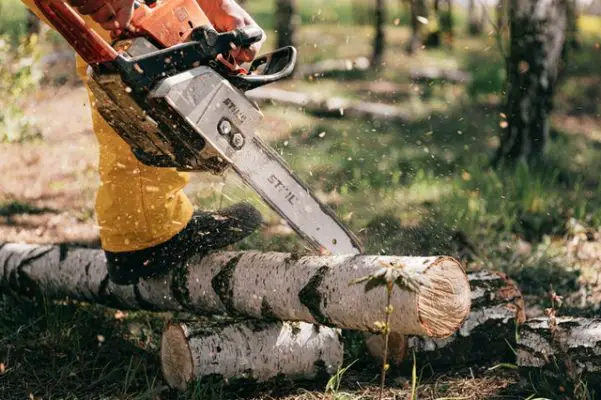
Before we get to it, it is worth noting that there are left-handed chainsaws in the market. Hence, it is important to check user instructions when you buy a new chainsaw. That said, the vital part of mounting your chain is ensuring that you get the direction of a chainsaw blade right.
What you need to remember:
- Cutter tip should point towards the bar tip or rather, while holding the chainsaw, make sure that the cutting edges face away from you,
- The depth gauge is usually shorter than the cutter tip.
- Chainsaw blades go on either way
- All chainsaws rotate clockwise.
- The sharp edge should face the clockwise direction.
- The risk of chain-breaking is minimal if the tool is used as instructed by the manufacturer.
The pointy edge of the blade should face toward the direction of rotation. That means making sure that:
(1) The pointy edges of the blade rotate on top of the chain bar.
(2) The blades move away from the body of the machine.
(3) The blades move toward the tip of the bar.
Do not forget to clean the chain and bar. Sawdust and other debris stuck in the blade gaps can be removed using a small brush, which could be a toothbrush or paintbrush. For safety reasons, we recommend cleaning the chain and bar while wearing safety gloves. Remember, you are dealing with a sharp tool, and accidents may happen at any time.
How do I Know the Direction of a Chainsaw Blade is Right?
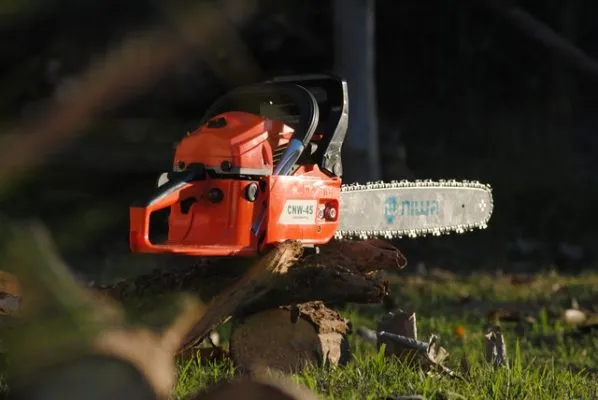
If it is your first time using a chainsaw, there are several ways to check if the direction of a chainsaw blade is okay. The easiest way to tell is to run a test.
As mentioned, if the chain is set backward, it will require more effort to cut through wood.
Consequently, the idea is to use the chainsaw to cut a smaller secured piece of wood. you want to keep the wood secured to keep it from turning into a projectile if the chain is set backward. What you are looking for is excessive rattling, smoking, or burning on the wood. Wood smoke and burning are signs of friction, indicating that the chainsaw blade is not set right. It may also indicate that the cutting edges are blunt. Therefore, be sure to sharpen the edges before a trial run.
Users can tell if the chain is set backward by performing the following step.
Look at the Chainsaw from the Top and Bottom
Remember, we mentioned that all chainsaws, left-handed or right-handed, turn in a clockwise direction. Because of that, the sharp edges of your chainsaw should run clockwise when in operation. When viewed from the top, the sharp edges should point away from the body of the chainsaw.
When viewed from the bottom, the teeth should face in the opposite direction. That is- toward the body of the chainsaw.
Is it Possible to Put a Chainsaw Blade Backward?
Yes, it is possible, the question is, should you and how can you tell? Most accidents associated with chainsaws happen because of negligence and lack of proper care and maintenance. For example, when replacing a chainsaw’s blade, you may make the mistake of putting the chain backward. The result of which will be that the chain will not cut. If it does, it will cut slowly, and that is problematic because of the reasons explained below.
The cutting teeth on a chainsaw remove debris in one direction. Because of that, installing the chain backward will result in smoking and sometimes damage to the chain. The damages do not stop there, meaning the direction of a chainsaw blade may also lead to excessive stress on the guide bar, clutch burnout, the chain may get blocked, and injuries if not careful.
What you need to remember:
- The cutters should not face you when in operation.
- Installing the chain backward will waste bar oil and may damage the chain link.
- Not oiling the chain will cause it to overheat and expand making the chainsaw a potential health and safety hazard.
What Happens if the Direction of a Chainsaw Blade is Not Set Right?
How can you tell if the blade is on backward?
If you are learning about the direction of a chainsaw blade, this is important to know. Let’s delve into it.
A sign that the chain is on backward is poor performance or a blunt saw. However, if unsure of what the problem is, it is advisable to seek help from an experienced professional.
Apart from motor damage, a dull chainsaw, or if the direction of a chainsaw is not set right, as mentioned, may result in overheating, and in some cases, the chain may break releasing sharp projectiles that may cause serious injury.
Regular chainsaw users can easily tell if a chainsaw blade is set wrong just by looking at it. However, if you are new to chainsaws, you may not be able to tell if the blade is set right. Using a chainsaw in that condition will result in the following problems.
Motor Damage or Deterioration
Not setting the direction of a chainsaw blade right will force the user to apply extra pressure because the dull edges will be the ones in contact with the wood. The pressure will affect the motor impacting durability.
Clutch burnout
Installing a chainsaw backward may cause the tool to stall, and smoke may start to come out. This may be a symptom of clutch burnout. If the clutch burns out the chainsaw will no longer work, meaning you will either have to replace the clutch or buy a new chainsaw.
Apart from installing the chain backward, installing it too loosely or too tight may potentially cause clutch burnout.
How do I check if the clutch on my chainsaw is damaged?
- Does the chain slip under load, or does the engine lose revs?
- Does the chain slow down while the engine is running at normal revs?
If yes, these are potential signs of a damaged clutch or fuel problem. We recommend that you avoid using the tool until you get a second opinion from a trained professional. Other signs include:
- The chain slips while cutting
- The motor will not pull the chain
Expert tip: if the clutch is not damaged, check the spring.
Damaged guide bar
Another problem associated with the direction of a chainsaw blade is stress on the guide bar. This problem happens because the blade not cutting or cutting slowly may prompt the user to use extra force, this extra force will translate into stress on the guide bar which may end up damaging it.
Broken chain link
Although low risk, chain breaks can be dangerous. Consequently, experts recommend wearing protective clothing while operating a chainsaw. That said, improperly installing a chainsaw blade may lead to damage. That damage increases the possibility of breaking during use. We recommend:
- Invest in commercial chainsaws instead of homeowner saws: the former is built for heavy-duty work and is thus more durable.
- Run the chain over the bar once or twice before starting the saw to check for kinks or hiccups.
- Check the links by hand.
The Direction of a Chainsaw Blade and Kickback Accidents
As mentioned, the likelihood of the chains breaking is low, however, chainsaw kickback accidents can happen at any time. “Kickback” refers to a sudden jolt by the chainsaw in an upward direction.
What causes chainsaw kickback?
- Improperly installed chains or parts/the direction of a chainsaw blade .
- Poor chain tension
- Dull chains
- Incorrectly fitted parts
- Cracked or broken chain
- Pinched chain
- Cutting uneven surfaces
- Lack of proper maintenance
To avoid serious injuries that may result from chainsaw kickback, we recommend wearing protective clothing while using a chainsaw and inspecting the tool before use. It is also worth noting that ninety percent of chainsaw-related accidents happen because of user error. Consequently, you must pay attention to what you are doing.
How to Safely Replace a Chainsaw Chain
While learning about the direction of a chainsaw blade, this question often arises: How to safely replace a chainsaw chain? Replacing a chainsaw blade is not as difficult as it sounds, what is difficult for some newbies especially ones who bought the tool second hand, is finding a chain the matches the chainsaw. Note that the number of links in a chain is specific to the length of the bar on a chainsaw. Because of that, you must purchase the right length chain or one built for the model.
If you have the box, model number, and other identifying information, you may use that to find a suitable chain online or at a retailer near you. Simply key in the chainsaw’s model number into your favorite search engine or visit the manufacturer’s website. this raises a question, are generic chainsaw chains bad? Or is mixing chainsaw blades, okay?
The answer to that question is that it all boils down to compatibility and quality. I am against mixing chainsaw brands because of the possible dangers of kickback. However, if you choose to mix brands, we recommend only using compatible, high-quality chains. That means, do not go for cheap. Instead, go for quality.
How to Find the Right Chainsaw Chain
Finding the right chain will lessen the possibility of getting the direction of a chainsaw blade wrong. Here is what you need to do:
Check the Sequence and Cutter Type
Depending on the manufacturer, the direction may be skip, semi skip, or standard. If you cannot tell the difference just by looking, we recommend taking photos of the chain and comparing it to the replacement before purchase.
- Standard sequence: the most cutting teeth, built for heavy-duty work.
- Semi skip: half of the teeth are close together, and the other half resembles a full skip
- Full skip: suitable for cutting large softwood.
The Direction of a Chainsaw Blade and Maintenance
Without a blade, a chainsaw cannot perform its intended duty. Consequently, the chain is the most important part of the device. Getting the direction of a chainsaw blade right is just one part of the equation, meaning, you must also consider regular maintenance.
When it comes to chainsaw blade maintenance, the factors to consider are chainsaw tension, depth of gauge setting, and sharpening angles.
Worth noting is that the direction of a chainsaw blade will be impacted by these factors meaning, If you have it on backward, it may be difficult to get the tension right or to sharpen the blade.
The Depth of Gauge and Sharpening the Teeth
The thickness of the wood chips the chainsaw removes with each cut -is dependent on the depth of the gauge. Maintenance requires a depth gauge tool and a flat-file. The idea is to place the gauge tool over the cutter and file off the excess. Experts recommend regularly checking the depth of gauge
Regularly sharpening the teeth will lessen the possibility of kickbacks caused by dull chains.
Chain tension
As mentioned, the direction of a chainsaw blade affects chain tension. The issue with operating a chainsaw that has a loose chain is that the chain may fly off turning into a safety hazard -and if it works, it will not cut wood properly.
It is also worth noting that a loose chain increases the possibility of kickback, Furthermore, the tension that results from using a loose chain will place pressure on the sprocket lowering the device’s lifespan.
What to remember
- Do not adjust chainsaw tension immediately after use or while the chain is still hot.
- Wear protective gloves to prevent injuries while adjusting chain tension.
- If the chain is too tight, it may break when in use.
- Regularly tension the chain to lessen the possibility of kickback.
Finding a Low Kickback Chainsaw Chain
A low kickback chainsaw chain is a good investment if you are concerned about mixing up the direction of a chainsaw blade. What is special about a low kickback chainsaw chain is that it is built to lower the possibility of kickback accidents. The chain below fits multiple chainsaw models including Remington, Craftsman, Echo, and Homelite.
Oregon S56 AdvanceCut Chainsaw Chain for 16-Inch Bar, 56 Drive Links, Low-kickback chain, fits Makita, Echo, Husqvarna, Wen and more Grey
Check on Amazon
Before you purchase a chainsaw blade, it is in your best interest to check if the item matches your chainsaw. When in doubt, the right thing to do is purchase a chain manufactured or recommended by your chainsaw’s manufacturer.
How do you know if a chain will fit?
- Check the drive links.
- Chain pitch: this is the distance between drive links that you measure by counting three links in a row then dividing by two.
- Chain gauge: this is the thickness of each drive link; the idea is to measure the section of the drive link inside the groove of the guide bar.
- Bar length: measure the guide bar from tip to base.
Use the results of the measurements to find a chain that fits your device if shopping online. You can find product information at the back of the package, so we recommend checking the package or product information before purchasing.
How Do You Tell When a Chainsaw Chain is Worn Out?
The direction of a chainsaw blade is not the only factor that could be affecting the device’s performance, the issue could be that the chain is worn out, the question is, how can you tell? With the instruction above, you already know how to tell if a chainsaw blade is installed backward. On the other hand, you know that chainsaw chain needs replacing if:
- The chainsaw blade points in the right direction but still requires putting more pressure on the wood when cutting.
- The chain “sands”, meaning it creates finer sawdust instead of rough threads.
- Crooked finish/chain not cutting straight.
- Multiple crooked or damaged teeth.
The point is, if you notice a performance drop after you sharpen the chains, or if the teeth are damaged, for safety and performance reasons, you should replace the chain.
Conclusion: Direction of a Chainsaw Blade
Overall, a chainsaw is one of the most dangerous tools that you may have in your home. Because of that, ensuring that the chainsaw blade points in the right direction and that the device is in good working condition will lower the possibility of accidents. Remember, user error is the leading cause of chainsaw accidents worldwide, therefore, when operating a chainsaw, make sure that you pay attention to the task at hand. That means checking for changes in performance and knowing when it is time to replace chainsaw blades.
The direction of a chainsaw blade, as mentioned, will affect performance, the easiest way to tell if it points in the right direction is to look at it from multiple angles -that is-top bottom, and the sides. Remember, chainsaws run in a clockwise direction meaning, if the teeth do not run in this direction, it means that something is not right. The good news is changing a chainsaw chain is not difficult, but, make sure that you do not do it while the device is running.
Before you purchase a new chain, check the manufacturer’s recommendations or the chain’s details usually found on the packaging or product specifications.
Your main concerns should be safety, maintenance, and performance. Therefore, sharpen the blades regularly, check the chain before use, and wear protective clothing when operating a chainsaw.

